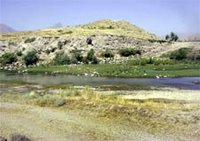Discovery of 35 Historical Sites in Qasr-e Shirin

Tehran, 6 February 2006 (CHN) -- Archaeological excavations in Qasr-e Shirin in Kermanshah Province led to the discovery of 35 historical sites belonging to the Neolithic (6500 BC) and Chalcolithic period (5000-3000 BC).
“Discovery of clays belonging to Uruk period (Early Mesopotamian civilization), and special bowls ( clay bowls belonging the beginning of written language), were the other discoveries in this historical site,” said Ali Hajbari, archaeologist and head of excavation team in Qasr-e Shirin.
According to Hajbari, among the discovered historical sites, some date back to the Middle Elamite, New Elamite and the Achaemenid era, while some contemporary evidence belonging to the Pahlavi era have also been discovered.
A 40-kilometer defensive wall, built by Khosrow Parviz to defend the Qasr-e Shirin had already been discovered during the archaeological excavations in Qasr-e Shirin. This discovered wall in Qasr-e Shirin continues to Iraq after passing through the border.
Sassanid channel is the other important historical evidence of Qasr-e Shirin which is aborted in Iraq. The water of Alvand River enters this channel through a trench, and after passing the eastern and northern parts of Qasr-e Shirin it flows towards Iraq. A rich civilization was established on the basin of this river in Qasr-e Shirin area.
This channel was constructed by sand stones and stucco. The method of constructing the channel on an uneven land is considered one of the world engineering feasts in irrigation style. In order for the water to flow smoothly in this channel, the ground had to be leveled first. In doing so, the channel was filled up to 7 meters above the ground level in some parts, while in some others the mountain cliffs were scraped or the earth was dug 10 meters.
The ruins near Qasr-e Shirin were excavated for the first time in 1891, and later in 1910 by British archaeologist and writer Gertrude Magaret Lowthian Bell (1868-1926).
Qasr-e Shirin or the Place of Shirin is the name of a historic city in Kermanshah Province, west of Iran. During his reign, Khosrow Parviz, the Sassanid King, built several palaces in this city including a palace he named after his queen, Shirin; hence the city got its name from there and is now called Qasr-e Shirin, literary meaning “Place of Shirin”.
The excavations in Qasr-e Shirin historical site will continue to 19th of February, while archeologists are hoping to find new architectural and historical evidence.

0 Comments:
Post a Comment
<< Home